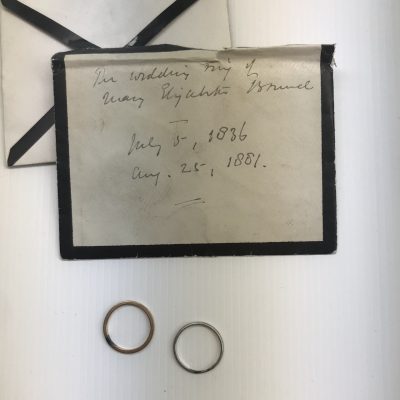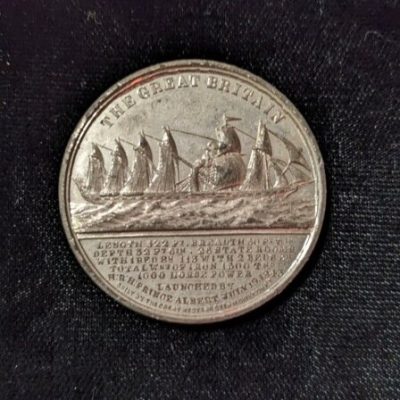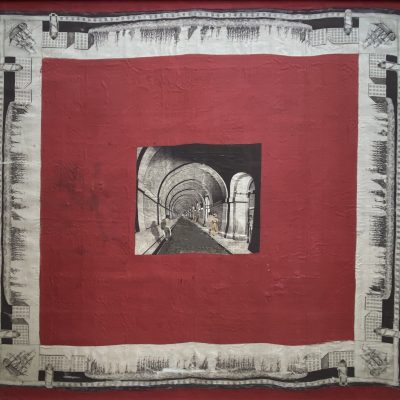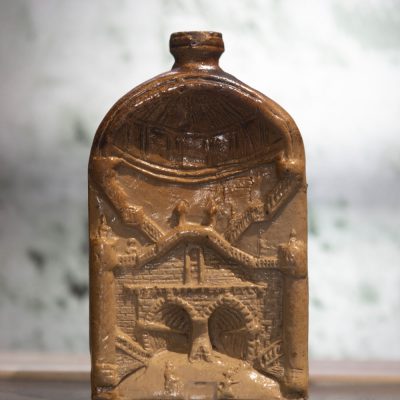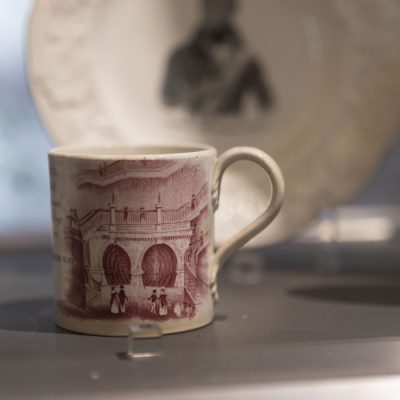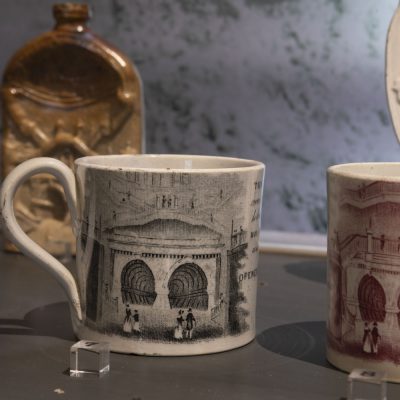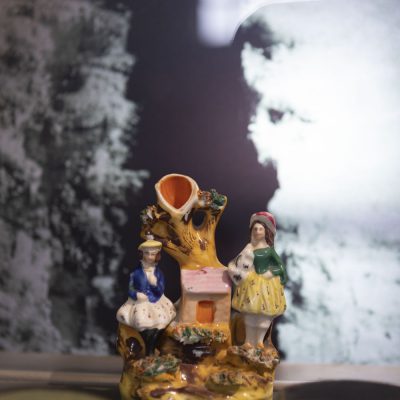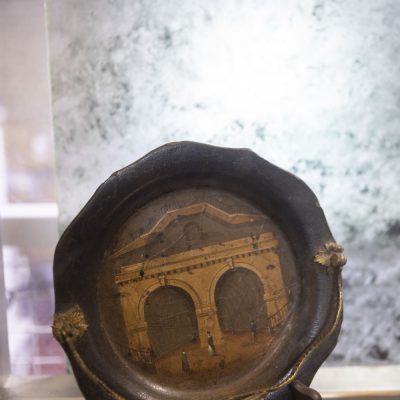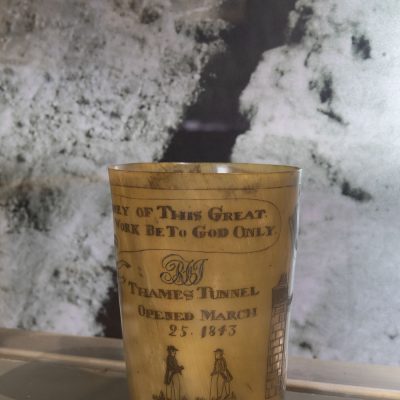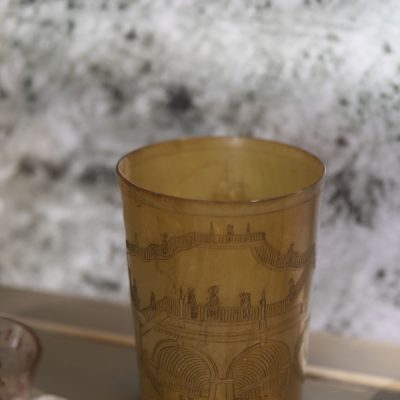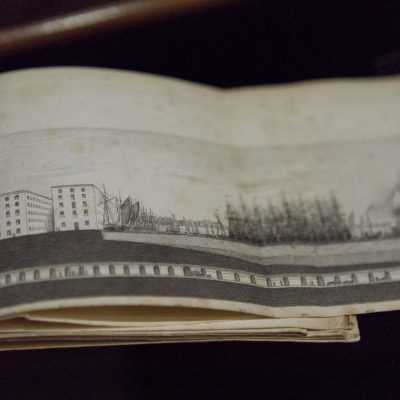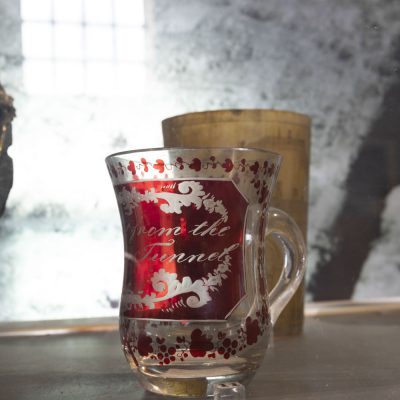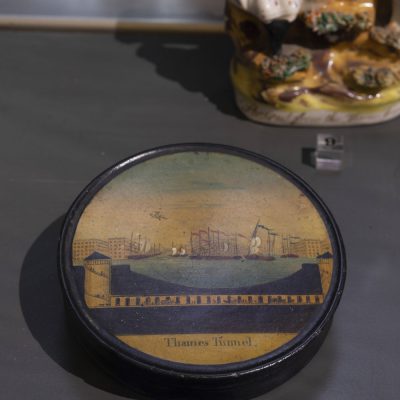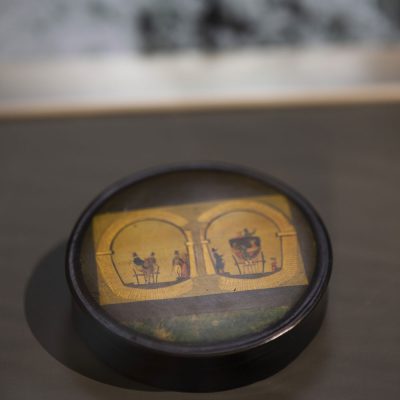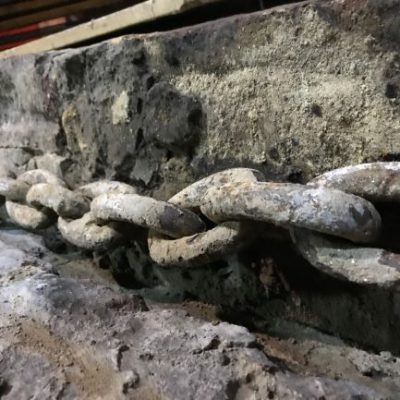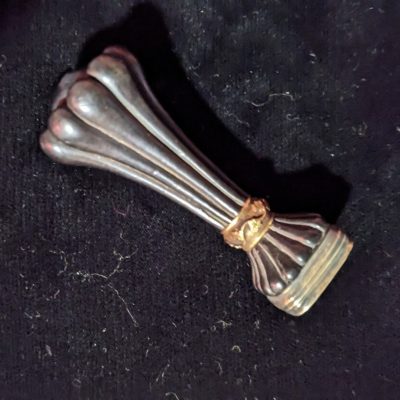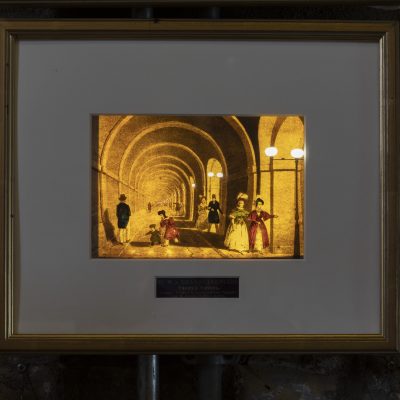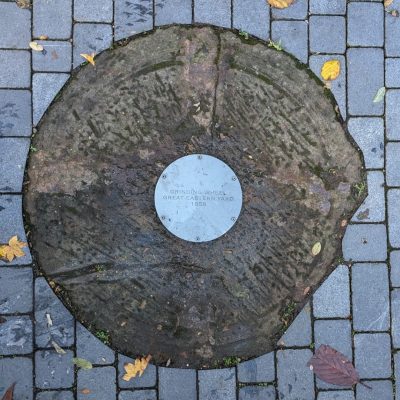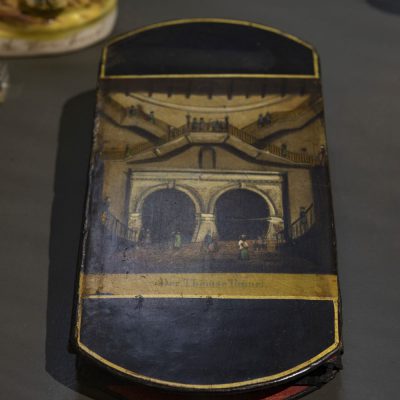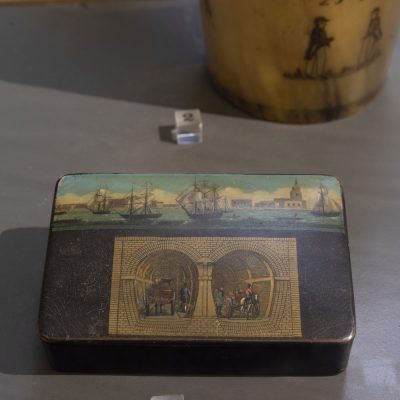Collection
Discover our collection of objects.
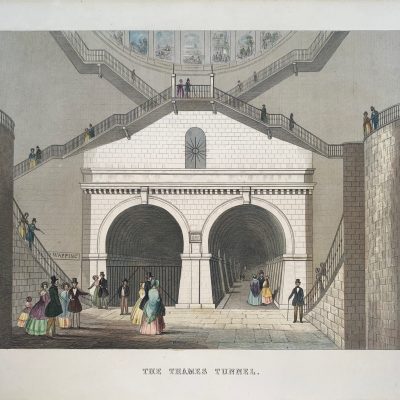
Print of the Wapping Entrance of the Thames Tunnel
Hand-coloured print of the Wapping entrance to the Thames Tunnel. Visible at the top of the image are paintings by I.B. Henkin, installed in 1843, of a range of subjects including Place de la Concorde in Paris; Windsor Castle; and the Leaning Tower of Pisa. It is unclear why the left-hand side of the Tunnel …
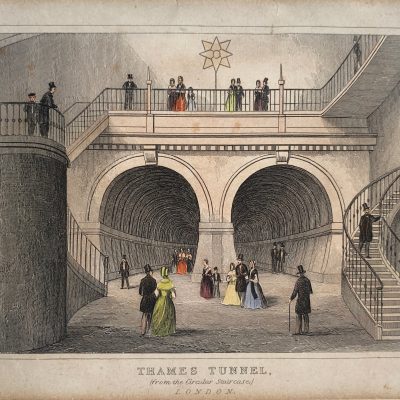
Print of the Rotherhithe Entrance of the Thames Tunnel
Hand-coloured engraving of the Rotherhithe entrance of the Thames Tunnel (built 1841). Produced for Dugdale’s England and Wales Delineated, though possibly sold as a standalone print.
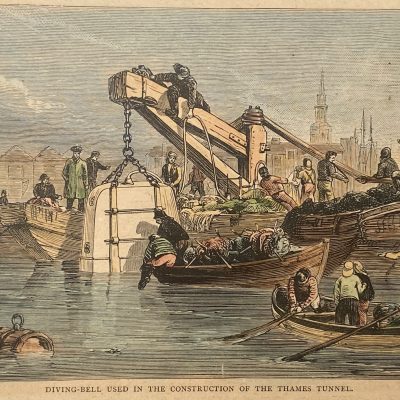
Print of the “Diving-Bell Used in the Construction of the Thames Tunnel”
Hand-coloured print of the operation of diving bell used to assess damage to the Thames Tunnel following flooding in the late 1820s, taken from Edward Walford, Old and New London: A Narrative of its History, its People, and its Places (London: Cassell and Company Limited, 1893). For a contemporary view of the operation of the …
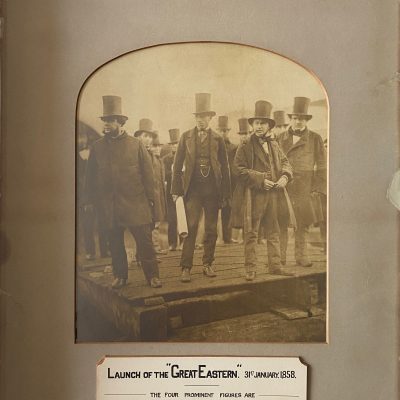
Photograph of Isambard Kingdom Brunel and others at the Launch of the SS Great Eastern
Early 1900s print of an 1857 photograph by Robert Howlett (1831-58), of a group of men including Isambard Kingdom Brunel, on the site of the construction of the SS Great Eastern, at Millwall on the Isle of Dogs. The series of photographs by the young Howlett documenting construction of the SS Great Eastern, then the …
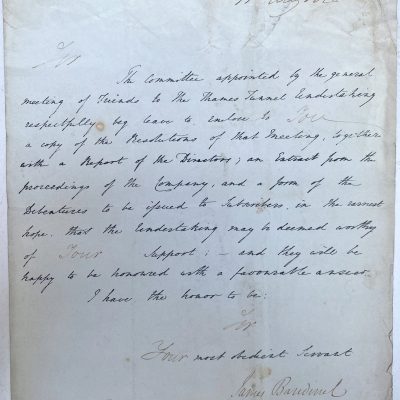
Circular letter seeking private funding for the Thames Tunnel
This is a part-lithograph, part-manuscript document, sent by the Thames Tunnel Company (TTC) to prospective investors to sound out possible private funding. One of an unknown number of copies sent over at least a two month period in mid-1828, this letter is evidence of the TTC’s ever more desperate attempts to raise private capital during …
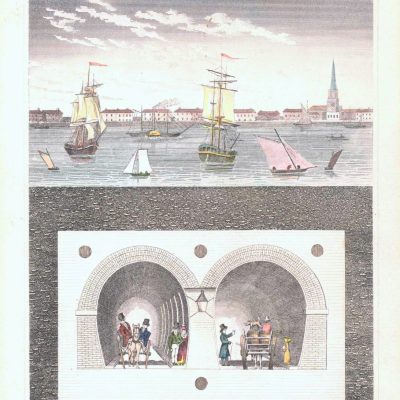
Print of the Thames Tunnel, and River Thames above
Hand-coloured engraving, showing the river at the top with boats and a church; and below it the double arches of the Thames Tunnel, with horses, carts and pedestrians. As such, the print must predate the opening of the Tunnel, which was never able to accommodate horses and carts. At the bottom, the legend “The Thames …
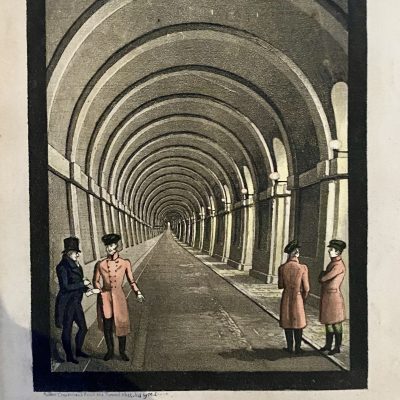
A View of the Western Archway of the Thames Tunnel
This print shows two pairs of men either side, in conversation in the tunnel, three of whom are wearing red jackets, one other in a black coat. The man in the black coat, wearing glasses and holding a paper and pen, appears to be Marc Brunel. It is likely the other figures represent other engineers …
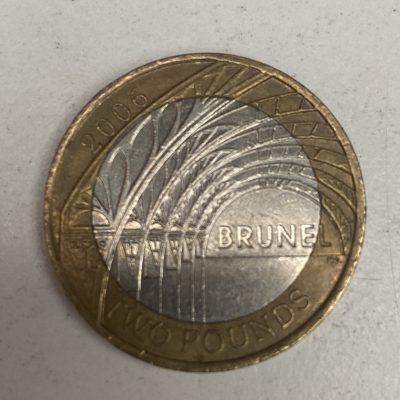
Isambard Kingdom Brunel Commemorative £2 Coin
Since the 1998 introduction of bi-metallic £2 coins, the Royal Mint has issued numerous commemorative editions of the coins. These editions have often focussed on science and technology. In 2006, as part of the bicentenary of Isambard Kingdom Brunel’s birth, the Mint issued two coins depicting Brunel and his works. This coin depicts the vaulted …
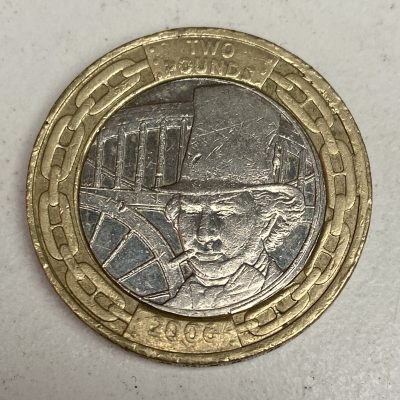
Isambard Kingdom Brunel Commemorative £2 Coin
Since the 1998 introduction of bi-metallic £2 coins, the Royal Mint has issued numerous commemorative editions of the coins. These editions have often focussed on science and technology. In 2006, as part of the bicentenary of Isambard Kingdom Brunel’s birth, the Mint issued two coins depicting Brunel and his works. This coin, designed by Rod …
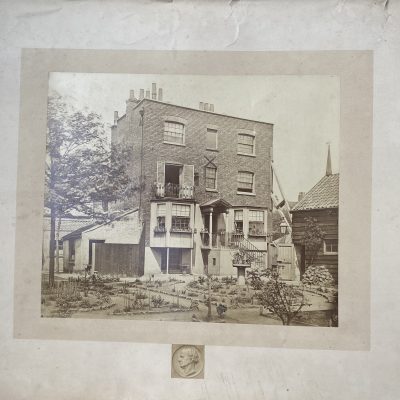
Photograph of the Brunels’ Rotherhithe Home
This is an albumen print of a photograph of the Brunels’ house at 26 Cow Court, immediately south of the Thames Tunnel works. The photograph has been mounted on card, with a printed portrait of Marc Isambard Brunel below. The photograph is commemorative, certainly datable to after the death of Marc Isambard Brunel in 1849, …
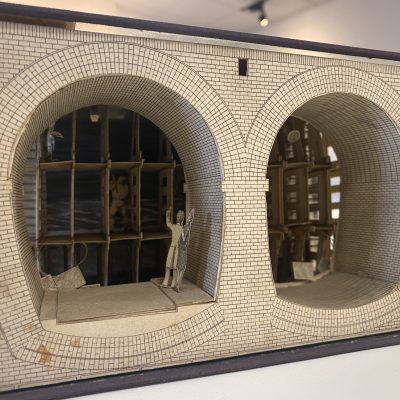
Cardboard Model of the Thames Tunnel and Tunnelling Shield
Two-part cardboard model depicting the tunnelling shield used to dig the Thames Tunnel between 1825-43; formerly owned by Marc Brunel
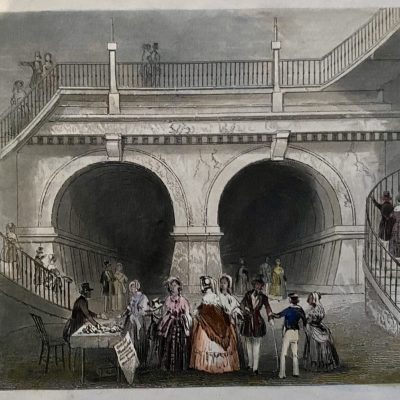
Print of Gottlob Wünderlich’s Thames Tunnel Stall
Hand-coloured print, showing Gottlob Wünderlich’s stall, identifiable by the text on the advert in front of the table in the print (‘Gottlob Wünderlich aus Leipzig. Hier spricht man [sic] Deutsch’, ‘Gottlob Wünderlich from Leipzig. German spoken here’). Appears to show the Rotherhithe entrance of the Thames Tunnel.
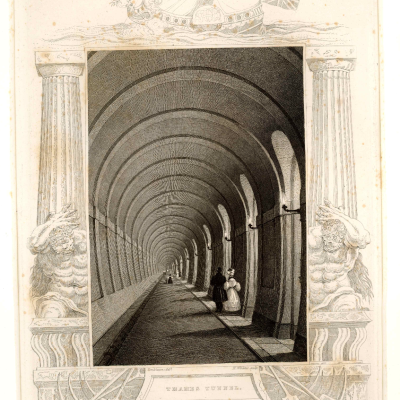
“Thames Tunnel” foreign-language print by William Tombleson
This is a steeplate engraving of the Thames Tunnel, with a border made up of doric columns supported by Atlas (?) on either side, a boat with British flag and Britannia sailing along the top edge, and motifs of oars. The print, produced a decade before the Thames Tunnel was opened in 1843, offers an …
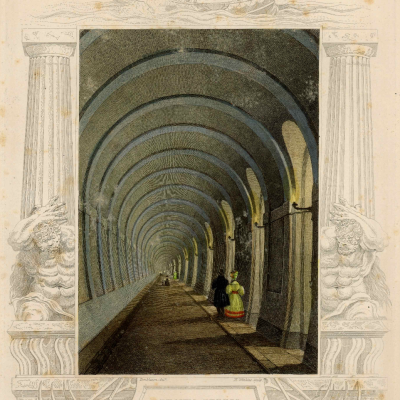
“Thames Tunnel” hand-coloured print by William Tombleson
Printed image of the Thames Tunnel, done in steelplate engraving, with a border made up of doric columns supported by Atlas (?) on either side, a boat with British flag and Britannia sailing along the top edge, motifs of oars, and the words “Thames Tunnel” along the bottom. The central image has been hand-coloured. Below …
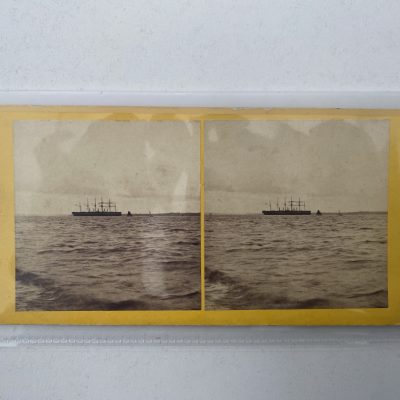
SS Great Eastern Stereocard
Anonymous stereocard showing the SS Great Eastern off the coast of Southampton
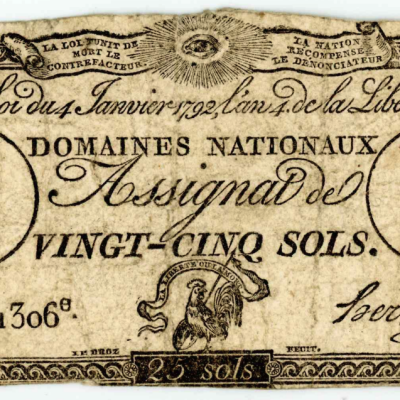
French Revolutionary Banknote
Assignat of 25 sols, printed following the French Revolution of 1789
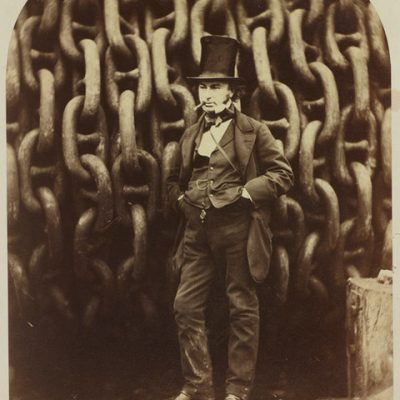
I.K. Brunel by the Launching Chains of the SS Great Eastern
Albumen print by Robert Howlett (1831-58)
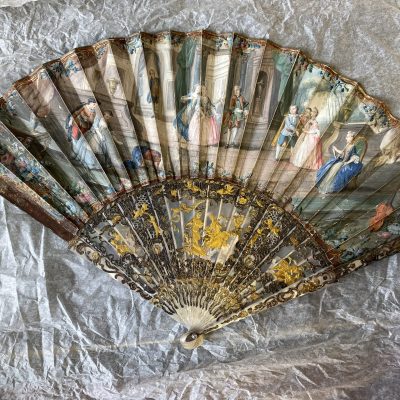
Painted hand fan
Mid-/late 1700s painted folding hand fan, possibly French, with watercolour images on either side, and struts with metallic filigree and mother of pearl inlay. Image on the obverse portrays a series of couples standing in classically-inspired architecture. Image on the reverse portrays a couple on a swing in a rural setting. Formerly owned by Mary …
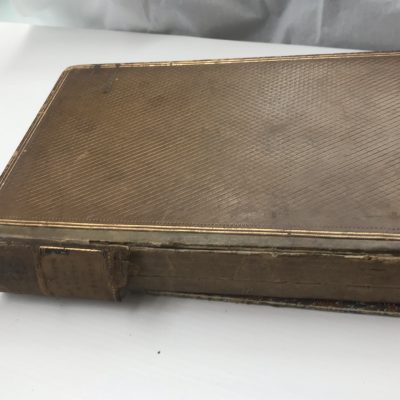
“Memoir of Sir Marc Isambard Brunel” by Richard Beamish
Copy of Richard Beamish’s Memoir of the Life of Sir Marc Isambard Brunel (1866), with a number of manuscript annotations on the flyleaves documenting the Brunel family’s genealogy. The volume also contains a manuscript dedication from John Kennedy (later Rev. John Kennedy, headmaster of Aldenham School, Herts., 1877-99) to Philip Edward Lee, dated 1865 on …

SS Great Eastern – Hull Print
Print of the SS Great Eastern's hull, from a photograph by Robert Howlett
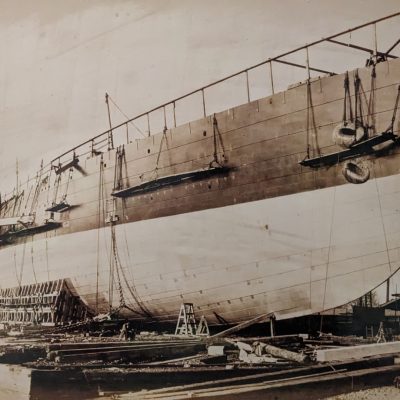
SS Great Eastern – Bow Print
Print of the SS Great Eastern's bow, from a photograph by Robert Howlett
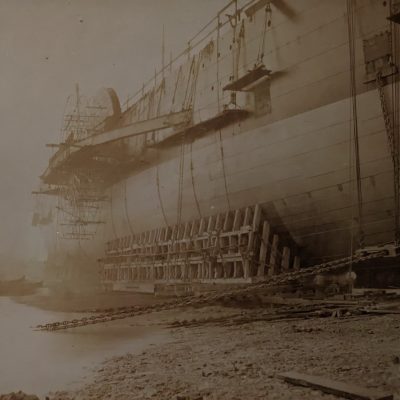
SS Great Eastern – Launching Cradles Print
Print of the SS Great Eastern on its launching cradle, from a photograph by Robert Howlett
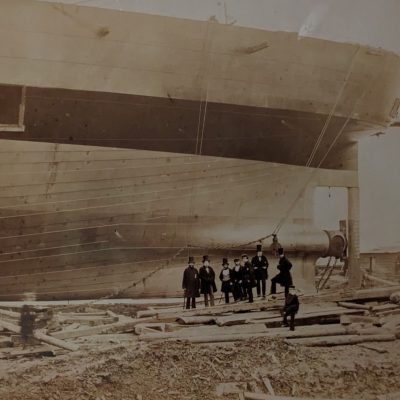
SS Great Eastern – Screw Shaft and Sternpost Print
Print of the SS Great Eastern's screw shaft and sternpost, from a photograph by Robert Howlett
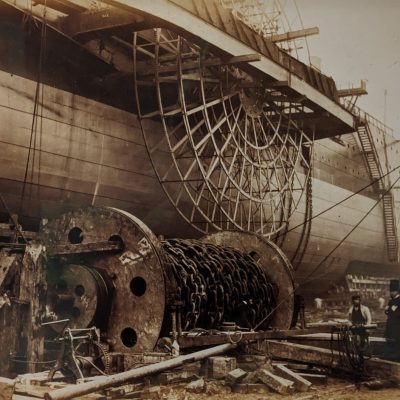
SS Great Eastern – Inspection of the Checking Drum Print
Print of the inspection of the SS Great Eastern's checking drum, from a photograph by Robert Howlett
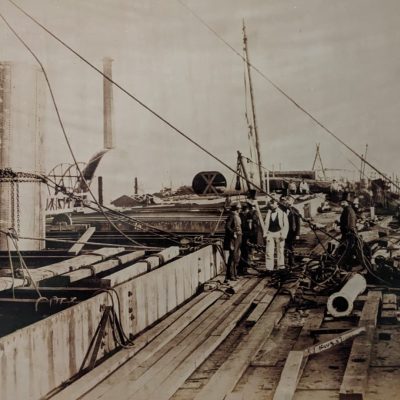
SS Great Eastern – Rear Deck Construction Print
Print of the SS Great Eastern's deck, from a photograph by Robert Howlett
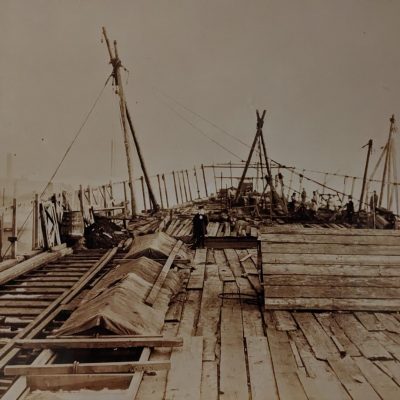
SS Great Eastern – Front Deck Construction Print
Print of the SS Great Eastern's deck, from a photograph by Robert Howlett
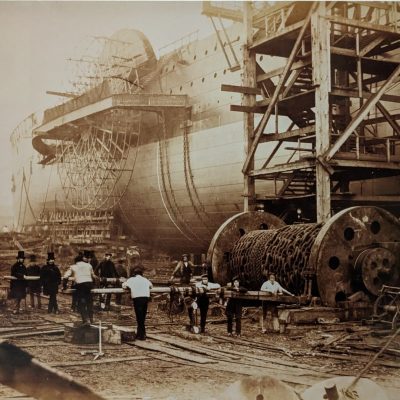
SS Great Eastern – Checking Drums Print
Print of the SS Great Eastern's checking drum, from a photograph by Robert Howlett
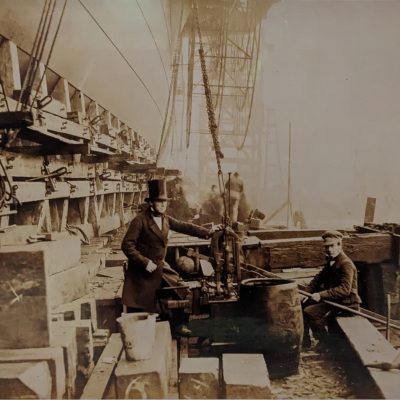
SS Great Eastern – Hydraulic Rams Print
Print of the SS Great Eastern's hydraulic rams, from a photograph by Robert Howlett
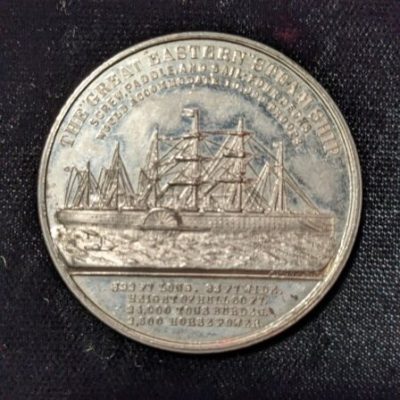
SS Great Eastern Medal
White metal medal commemorating the death of I.K. Brunel in 1859, with a depiction of Brunel (obverse) and the SS Great Eastern (reverse)
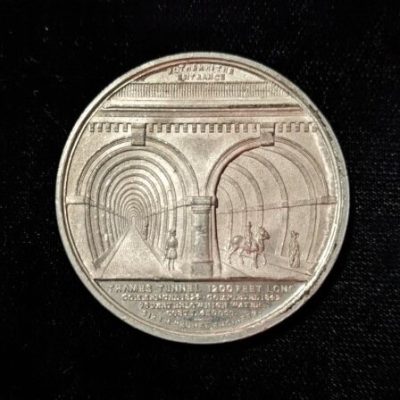
Thames Tunnel Medal
White metal medal depicting Marc Brunel (obverse) and the Thames Tunnel entrance (reverse)
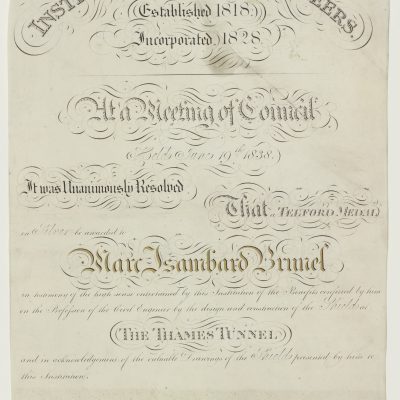
ICE certificate awarding Marc Isambard Brunel the Thomas Telford Silver Medal
If you’d like a print of the certificate displayed above, you can purchase one from the ArtUK online shop.
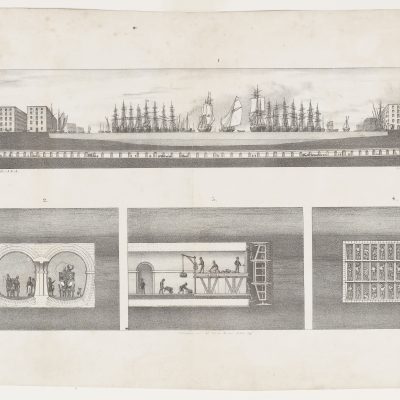
Four lithograph views of the Tunnel
This group of four lithographic drawings was drawn by William Westall (signed Wm. Westall A.R.A.) in 1827. Published both individually and separately, they were an important tool for promoting one of the most complex and challenging engineering projects ever undertaken. The uppermost drawing (no. 1) envisions the Tunnel in its entirety when completed, something which …
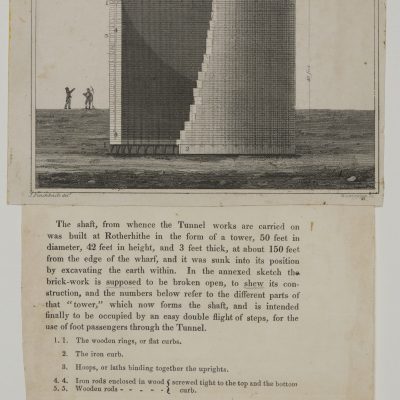
Printed sheet from Tunnel guidebook
If you’d like a print of the artwork displayed above, you can purchase one from the ArtUK online shop.
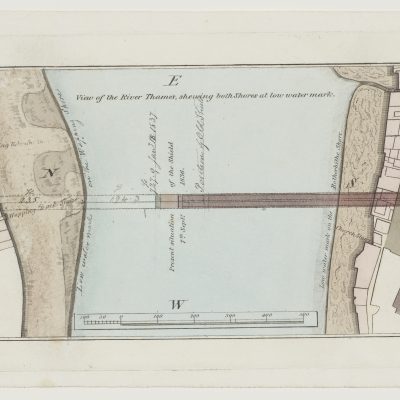
Map showing the progress of the Tunnel
If you’d like a print of the artwork displayed above, you can purchase one from the ArtUK online shop.
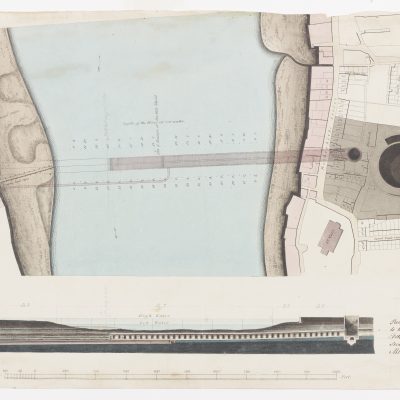
Lithographic sheet showing progress of the Tunnel
If you’d like a print of the artwork displayed above, you can purchase one from the ArtUK online shop.
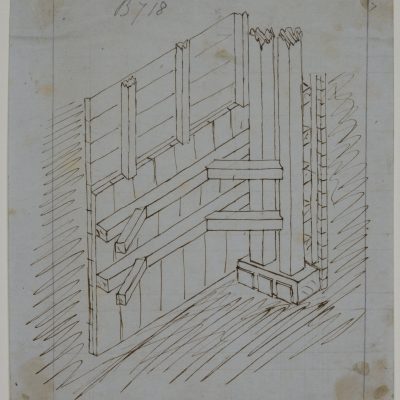
Sketch of the timbering for the removal of the old shield
If you’d like a print of the artwork displayed above, you can purchase one from the ArtUK online shop.
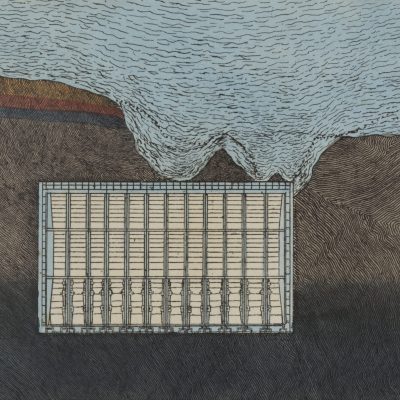
View of the shield
This watercolour wash view shows a cross section of the tunnel with the intrusion that caused the first flood on the 18th of May 1827. Unlike some of the other pieces in this collection showing the first flood (see LDBRU:2017.16 and LDBRU:2017.17), this piece is small in scale, at only 128mm x 90mm, and therefore …
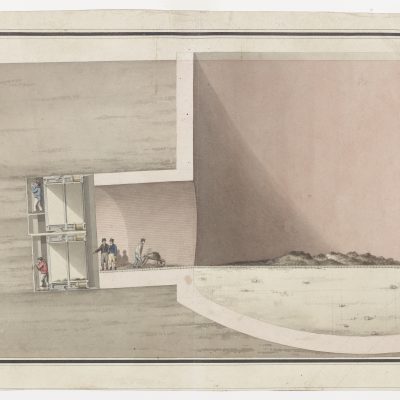
Watercolour of planned Shaft and section of a Tunnel
If you’d like a print of the artwork displayed above, you can purchase one from the ArtUK online shop.
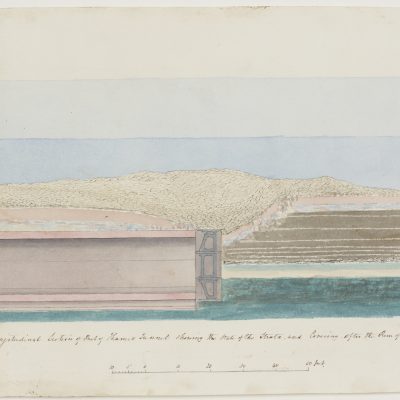
Side view of the Thames Tunnel after flooding
If you’d like a print of the artwork displayed above, you can purchase one from the ArtUK online shop.
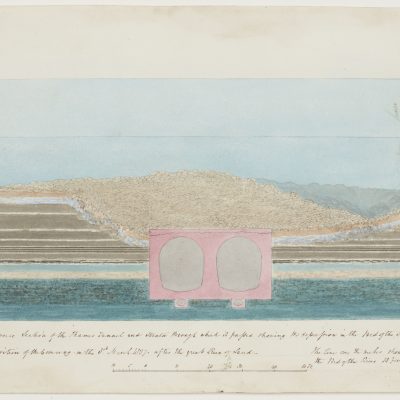
Cross-section of the Thames Tunnel after flooding
If you’d like a print of the artwork displayed above, you can purchase one from the ArtUK online shop.
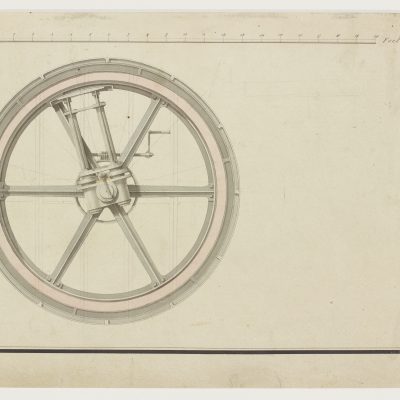
Watercolour of a cylindrical tunnelling shield
An early watercolour technical illustration depicting two cross sections of an early design for the tunnelling shield. This piece was likely drawn by Joseph Pinchback, Brunel’s chief mechanical draughtsman, and is cut from a sheet dated September 1818. See LDBRU:2017.5 and LDBRU:2017.20 for the complete page and other views of the design. Brunel’s patent no. …
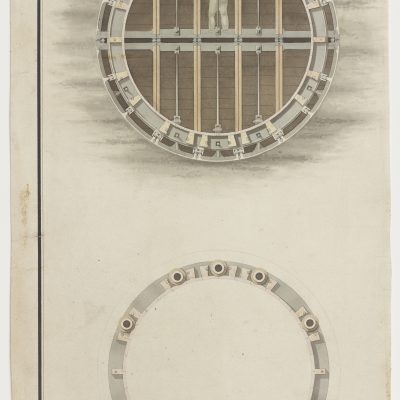
Two watercolour views of a cylindrical tunnelling shield
An early watercolour technical illustration depicting two cross sections of an early design for the tunnelling shield. This piece was likely drawn by Joseph Pinchback, Brunel’s chief mechanical draughtsman, and is cut from a sheet dated September 1818. See LDBRU:2017.5 and LDBRU:2017.20 for the complete page and other views of the design. In Brunel’s patent …
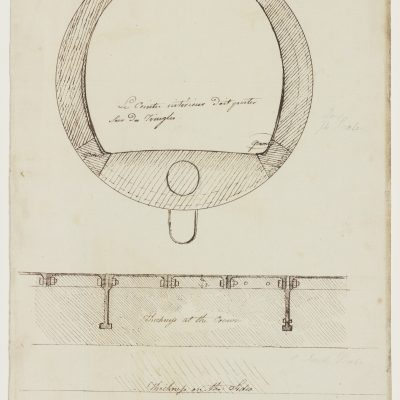
Sketch for a proposed cast-iron tunnel
If you’d like a print of the artwork displayed above, you can purchase one from the ArtUK online shop.

Side view of the flooded Tunnel
This watercolour shows a longitudinal section of the tunnel with two individuals inspecting the shield after the first flood of 18 May 1827, and is attributable to Brunel’s chief mechanical draughtsman, Joseph Pinchback. It is one of several pieces in this collection about the first flood, with others including LDBRU:2017.16 and LDBRU:2017.24, as well as …
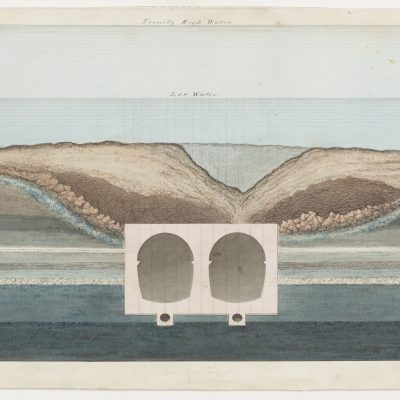
Cross-section of the Tunnel and displaced ground
This watercolour shows the effect the first flood of 18 May 1827 had on the riverbed, and is signed by Brunel’s chief mechanical draughtsman, Joseph Pinchback. It is one of several pieces in this collection which show the effects of the first flood. Others include LDBRU:2017.17 and LDBRU:2017.24, as well as Brunel’s descent in the …

Watercolour of the timbering for the removal of the old Shield
If you’d like a print of the artwork displayed above, you can purchase one from the ArtUK online shop.
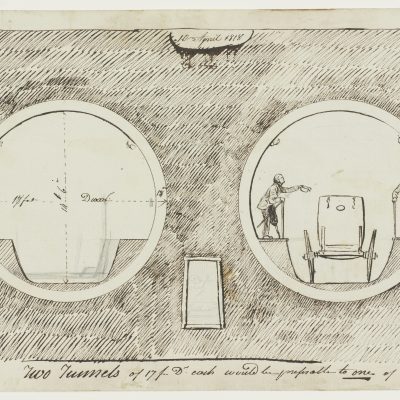
Sketch of a proposed cylindrical tunnel
This is a sketch-plan of a proposed tunnel, drawn by Marc Brunel and dated 10 April 1818. Only a few months prior in January 1818, Brunel had submitted his patent for ‘forming tunnels or drifts underground in which he included designs very similar to those drawn here and in LDBRU:2017.10. On the left side, there …
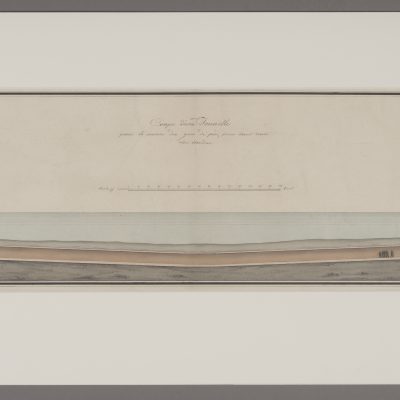
‘Cross-section of a Tunnel for the use of infantry, shown in its full extent’
This watercolour illustration, signed and dated by Joseph Pinchback, 1818 (‘Drawn by J. Pinchback, 1818’) shows a cross-section view of an early tunnel design. It is captioned, in Marc Brunel’s hand, ‘Coupe d’une Tonnelle pour le service des gens de pied, prise dans toute son étendue’, or ‘Cross-section of a Tunnel for the use of …
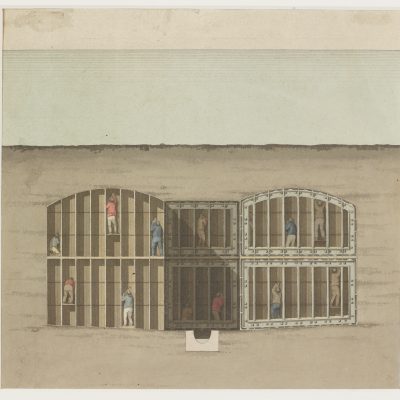
Watercolour of proposed three-part Shield
If you’d like a print of the artwork displayed above, you can purchase one from the ArtUK online shop.
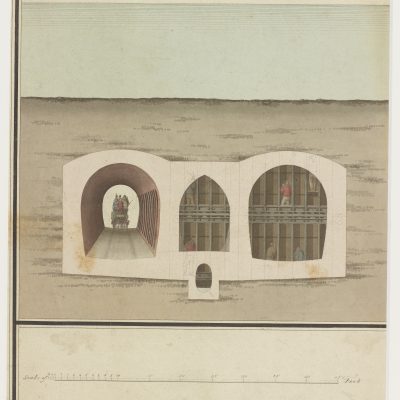
Watercolour of proposed three-part tunnel
If you’d like a print of the artwork displayed above, you can purchase one from the ArtUK online shop.
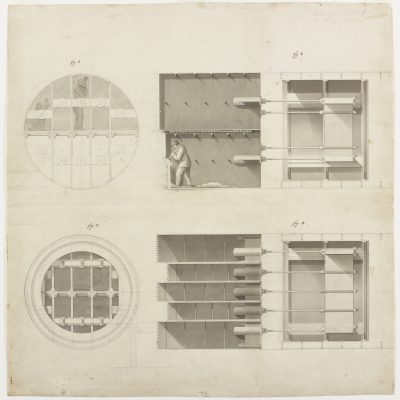
Four views of the Tunnelling Shield
This grisaille watercolour is a technical illustration of one of Brunel’s early designs for the Tunnel, which he likely drew himself. At some point, the page has been cut and squared off. It is a near-identical version of what appears in Brunel’s Patent no. 4204 “Forming tunnels or drifts underground” from January 1818, in which …
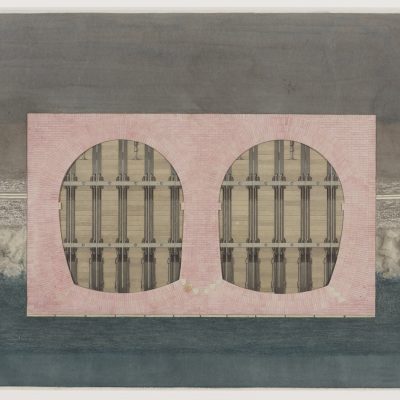
Section of tunnel with overlay
Uniquely, this object is made up of a pair of watercolours intended to be placed on one another. Both show the strata of earth through which the Tunnel was dug, but, where the under section shows the tunnelling shield, the overlay shows the finished brickwork with cutouts in the centre to enable the image of …
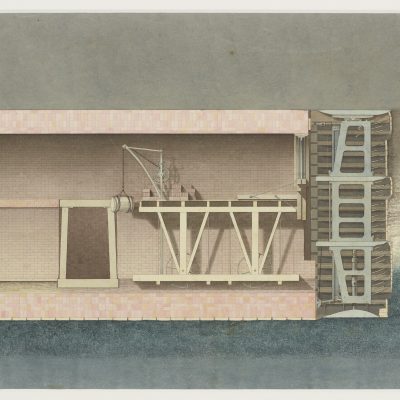
Watercolour of the Tunnel and Shield
This watercolour piece dates from the early 1820s and depicts a chronology of the tunnelling process. On the far right-hand side, the different strata of earth are distinguished with different patterns and colours. On the left is the tunnelling shield, its movable stage, which supplied bricks and other building materials to the front, and two …
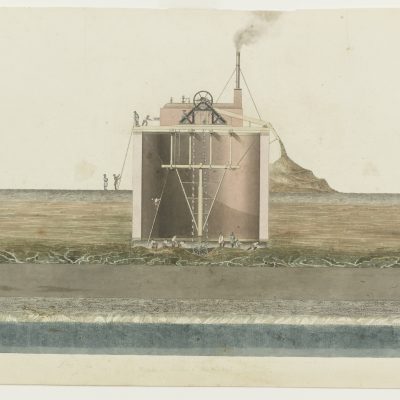
Watercolour of the Rotherhithe Shaft
A watercolour cross-sectional illustration of the tunnel shaft, likely done in 1825. On the 16th of February 1825, permission was granted to clear the ground for a sinking shaft 50 feet in diameter and 42 feet in height. Shortly after, on the 3rd of March, the brickwork began and thus marked the beginning of the …
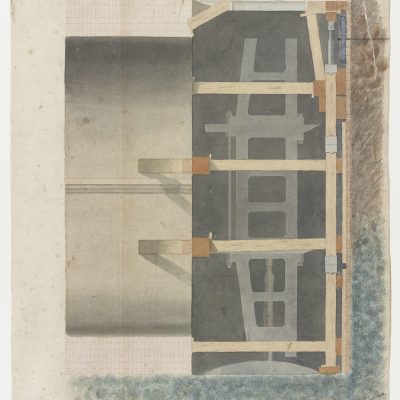
Watercolour of the second tunnelling Shield
If you’d like a print of the artwork displayed above, you can purchase one from the ArtUK online shop.
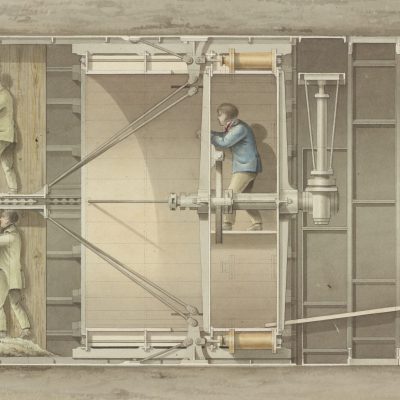
Watercolour of proposed tunnelling Shield
An early watercolour technical illustration of the tunnelling process. This piece was likely drawn by Joseph Pinchback, Brunel’s chief mechanical draughtsman, and is cut from a sheet dated September 1818. See LDBRU:2017.5 and LDBRU:2017.20 for the complete page and other views of the design. Two miners are featured excavating earth inside individual compartments. Close inspection …
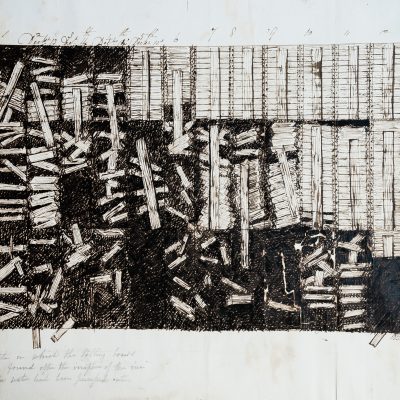
Sketch of damage following flooding
If you’d like a print of the artwork displayed above, you can purchase one from the ArtUK online shop.
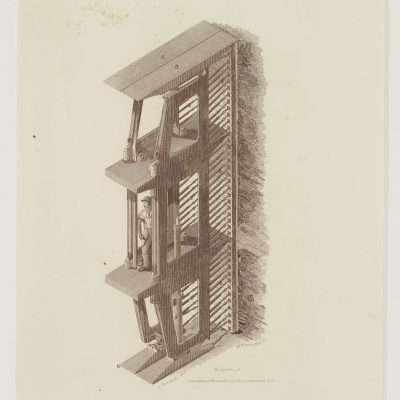
Print of one frame of the Shield
This engraving was done by William Warrington, who worked closely with the Thames Tunnel Company both as an engraver and printer of some of the tunnel guide books. It is most likely a copperplate engraving, and reproduces a drawing done by Richard Beamish, one of Brunel’s engineers, which can be seen here. Both pieces feature …
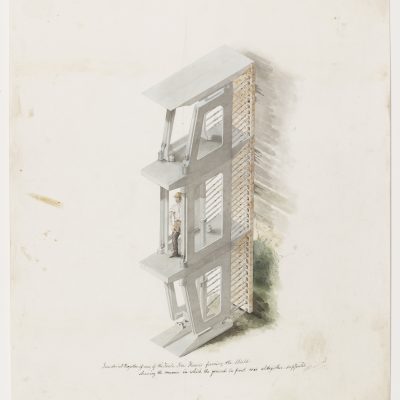
Watercolour of one frame of the Shield
This watercolour, signed R. Beamish (Richard Beamish, resident engineer on the Tunnel), provides a clear visualisation of how the tunnelling shield was formed and worked. It is captioned Isometrical projection of one of the Twelve Iron Frames forming the Shield/ shewing the manner in which the ground in front was altogether supported, and depicts a …
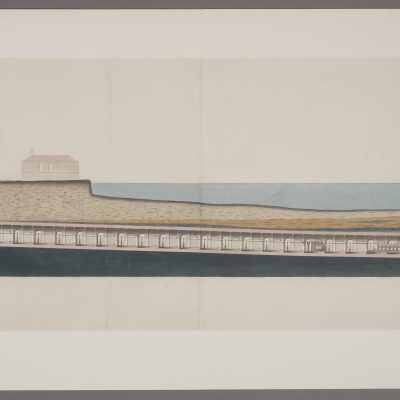
Watercolour cross-section of the Tunnel
This is a cross-sectional view of the Thames Tunnel mid-construction, believed to have been drawn by Brunel’s chief mechanical draftsman, Joseph Pinchback, during or shortly after 1831. By this point in the Tunnel’s history, progress had come to a complete standstill. A second flood and subsequent failure to secure additional funding had ended in the …
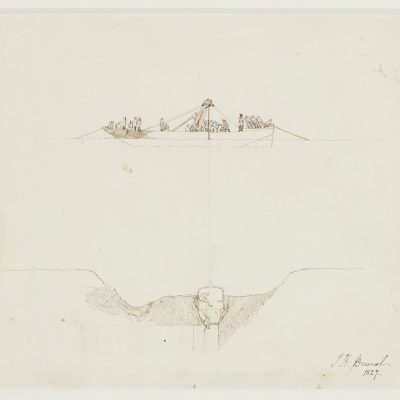
Sketch of a descent in the diving bell
This sketch, drawn with pen and ink on wove paper, is signed and dated 1827 by Isambard Kingdom Brunel. It depicts his descent in a diving bell to inspect the damage following the first flood that occurred on the 18 May 1827. It shows the bell lowered and suspended by a boat crewed by twenty …
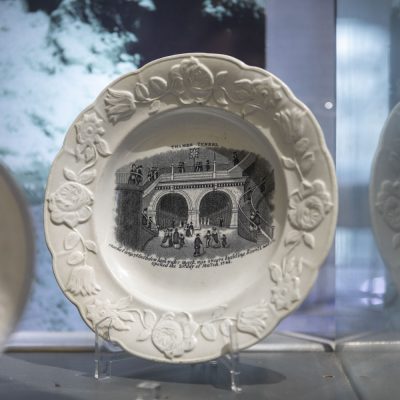
Pottery plate Thames Tunnel
Pottery plate showing the Thames Tunnel with decorative rim and with text starting '1200 Feet Long'
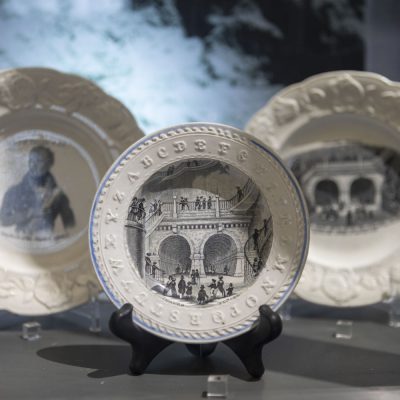
Blue-rimmed pottery plate Thames Tunnel
Pottery plate showing the TT and with blue rim and alphabet embossed on plate
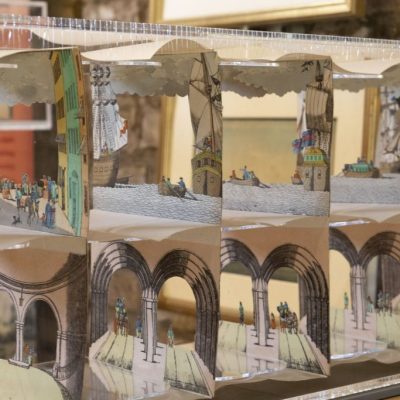
Thames Tunnel Dual-Layer Peepshow
A contemporary dual-layer peepshow before 1843, with vista above and below the Thames
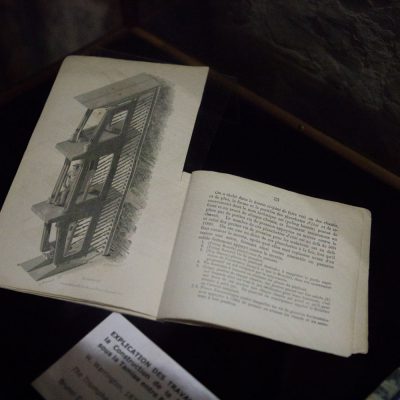
Tunnel guide French
Illustrated French-language guidebook to the Thames Tunnel Works, printed 1839.

Thames Tunnel Stereoscopic Peepshow
A contemporary peepshow circa 1852, with a vista of the Tunnel

Yates shaft watercolour
A fine and important topographical water colour of the Shaft of the Thames Tunnel by George Yates, dated 1835
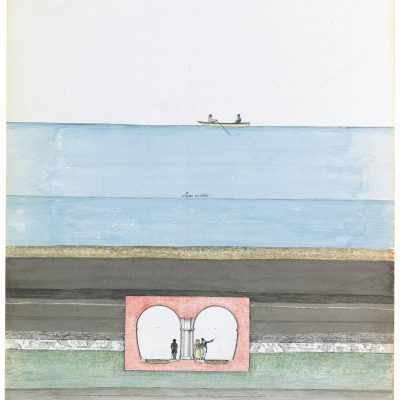
Brunel tunnel watercolour
Watercolour of the Thames Tunnel and river above, signed by Marc Brunel, 1835
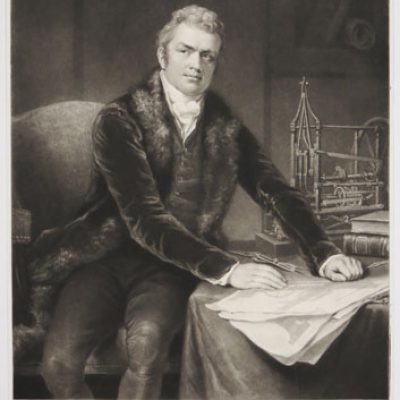
Marc Brunel mezzotint
This print depicts Marc Brunel early in his career in Britain, before work had begun on the Thames Tunnel. The print was published on 30 March 1815 by Charles Turner (1773-1857), a London engraver and publisher. The print reproduces a painting of Brunel done in 1812-13 by James Northcote which was first exhibited in 1814, …
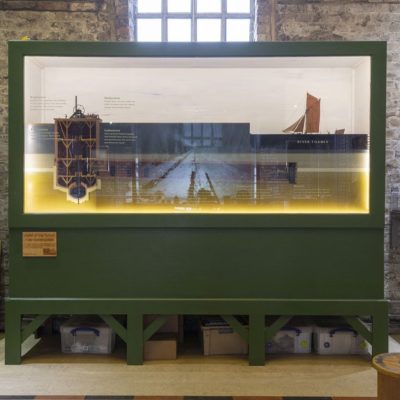
Sectional Model of Thames Tunnel Under Construction
Sectional model of Thames tunnel, 1826, by Severn-Lamb Limited, England

‘Leviathan’ Scrimshaw Shell
Shell engraved with a picture of a steam vessel, captioned: ‘Steam ship Leviathan. Designed by I.K. Brunel Esqr. F.R.S. Built by I.J. Russel Esq. Launch 31 Jany. 1856. Tonnage 24000 tons, Power 2600 horses, Length 690 feet, depth 60 ft.’ The shell has had the outer surface polished to reveal the mother-of-pearl.
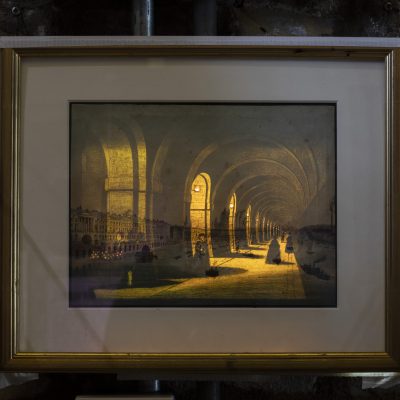
Polyorama Panoptique et Diagraphique pour Dessiner d’Après Nature
When placed in a special viewer with the lid closed, The Thames view is seen; when the lid is raised and light enters the box, the front image disappears, revealing the hidden image behind. In the Spooner Protean View presented by the Art Fund the tunnel

Spooner’s Protean View No. 28: The Thames Tunnel
Spooner produced several examples although little is known about the artist. This work depicts a view of The Thames Tunnel which changes into the Coronation Procession from Buckingham Palace when the lithograph is lit from behind.
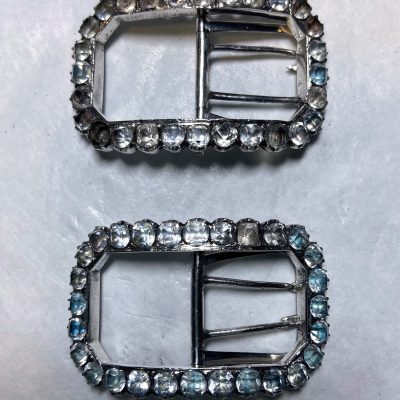
Marc Brunel shoe buckles
Pair of rounded oblong shoe buckles, originally belonging to Marc Brunel, decorated with paste glass gemstones
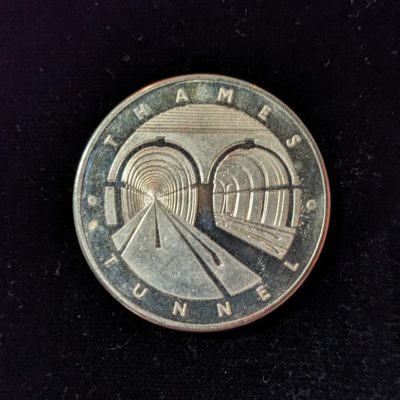
East London Line commemorative medal
Commemorative medallion issued at closure of East London line in 2007
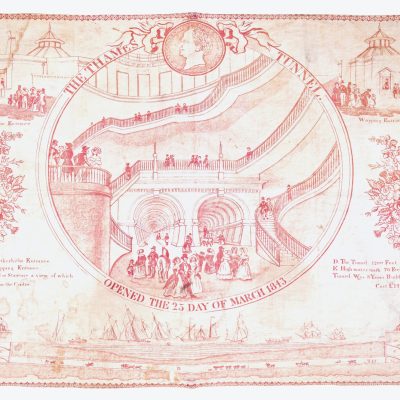
Thames Tunnel commemorative kerchief
Cream cotton/linen handkerchief with printed design in red, commemorating: "The Thames Tunnel opened the 25th day of March 1843.” The central illustration of the grand staircase is most similar to an engraving by Thomas H. Ellis, with additional figures added to the scene. The diagram of the Thames Tunnel is similar to one by William Westall. The quality of the handkerchief suggests it was a mass-produced, relatively cheap souvenir for visitors to the Thames Tunnel, that could have been bought within the tunnel itself.
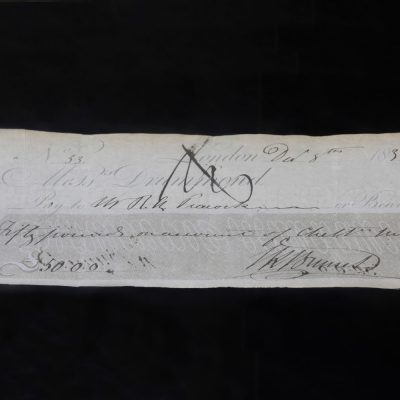
Cheque signed by Isambard Kingdom Brunel
A cheque from Isambard Kingdom Brunel dated December 8th 1835
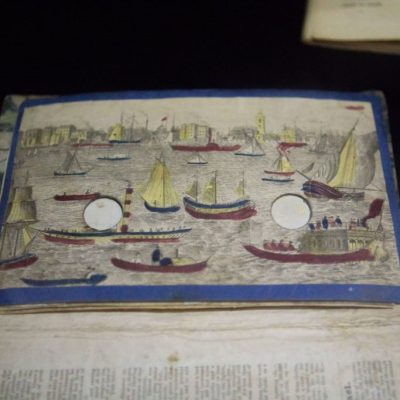
Thames Tunnel Peepshow with barge
A contemporary paper peepshow, circa 1843, depicting the Tunnel

